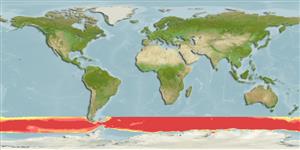Teleostei (teleosts) >
Gadiformes (Cods) >
Melanonidae (Melanonids)
Etymology: Melanonus: Greek, melan, -anos = black Greek, onos = hake.
More on author: Günther.
Environment: milieu / climate zone / depth range / distribution range
Ecology
Marine; bathypelagic; oceanodromous (Ref. 51243); depth range 150 - 3613 m (Ref. 11892), usually 600 - 1100 m (Ref. 9563). Deep-water; 50°S - 69°S
Circumpolar in subantarctic and temperate waters, occasionally being taken in the tropics (Ref. 6525). South Atlantic south of the Subtropical Convergence. Also captured recently in Prydz Bay, Antarctica.
Size / Weight / Age
Maturity: Lm ? range ? - ? cm
Max length : 18.7 cm SL male/unsexed; (Ref. 5209)
Oceanic species. Also mesopelagic (Ref. 7300). Has been recorded from over the continental slope in depths of 600 to 1,100 m (Ref. 9563). Biology unknown (Ref. 7130).
Life cycle and mating behavior
Maturity | Reproduction | Spawning | Eggs | Fecundity | Larvae
Chiu, T.S. and D.F. Markle, 1990. Melanonidae. p. 188-189. In O. Gon and P.C. Heemstra (eds.) Fishes of the Southern Ocean. J.L.B. Smith Institute of Ichthyology, Grahamstown, South Africa. (Ref. 5209)
IUCN Red List Status (Ref. 130435: Version 2024-1)
Threat to humans
Harmless
Human uses
Fisheries: of no interest
Tools
Special reports
Download XML
Internet sources
Estimates based on models
Preferred temperature (Ref.
123201): -1.4 - 2.6, mean 1.4 °C (based on 81 cells).
Phylogenetic diversity index (Ref.
82804): PD
50 = 1.0000 [Uniqueness, from 0.5 = low to 2.0 = high].
Bayesian length-weight: a=0.00372 (0.00143 - 0.00963), b=3.10 (2.88 - 3.32), in cm total length, based on LWR estimates for this (Sub)family-body shape (Ref.
93245).
Trophic level (Ref.
69278): 3.5 ±0.5 se; based on size and trophs of closest relatives
Fishing Vulnerability (Ref.
59153): Low vulnerability (13 of 100).
